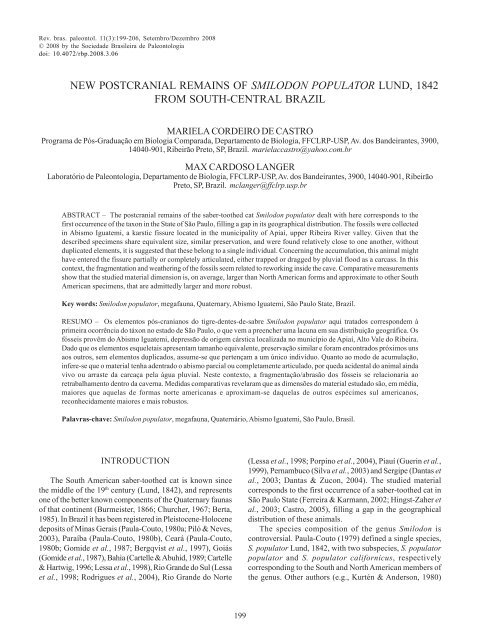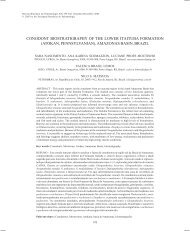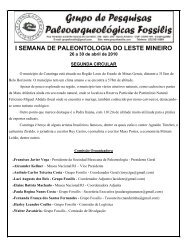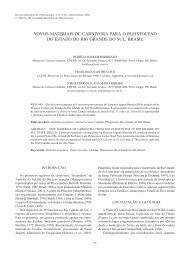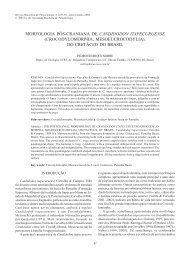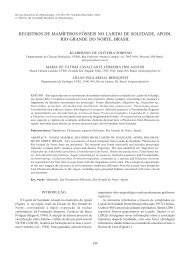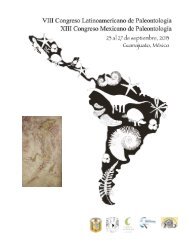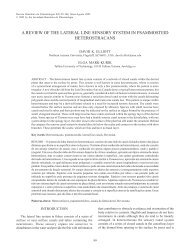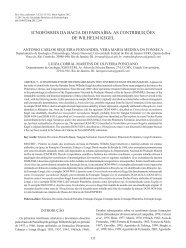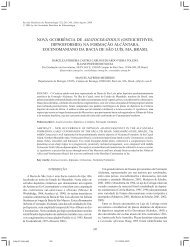new postcranial remains of smilodon populator lund, 1842
new postcranial remains of smilodon populator lund, 1842
new postcranial remains of smilodon populator lund, 1842
You also want an ePaper? Increase the reach of your titles
YUMPU automatically turns print PDFs into web optimized ePapers that Google loves.
Rev. bras. paleontol. 11(3):199-206, Setembro/Dezembro 2008<br />
© 2008 by the Sociedade Brasileira de Paleontologia<br />
doi: 10.4072/rbp.2008.3.06<br />
NEW POSTCRANIAL REMAINS OF SMILODON POPULATOR LUND, <strong>1842</strong><br />
FROM SOUTH-CENTRAL BRAZIL<br />
MARIELA CORDEIRO DE CASTRO<br />
Programa de Pós-Graduação em Biologia Comparada, Departamento de Biologia, FFCLRP-USP, Av. dos Bandeirantes, 3900,<br />
14040-901, Ribeirão Preto, SP, Brazil. marielaccastro@yahoo.com.br<br />
MAX CARDOSO LANGER<br />
Laboratório de Paleontologia, Departamento de Biologia, FFCLRP-USP, Av. dos Bandeirantes, 3900, 14040-901, Ribeirão<br />
Preto, SP, Brazil. mclanger@ffclrp.usp.br<br />
ABSTRACT – The <strong>postcranial</strong> <strong>remains</strong> <strong>of</strong> the saber-toothed cat Smilodon <strong>populator</strong> dealt with here corresponds to the<br />
first occurrence <strong>of</strong> the taxon in the State <strong>of</strong> São Paulo, filling a gap in its geographical distribution. The fossils were collected<br />
in Abismo Iguatemi, a karstic fissure located in the municipality <strong>of</strong> Apiaí, upper Ribeira River valley. Given that the<br />
described specimens share equivalent size, similar preservation, and were found relatively close to one another, without<br />
duplicated elements, it is suggested that these belong to a single individual. Concerning the accumulation, this animal might<br />
have entered the fissure partially or completely articulated, either trapped or dragged by pluvial flood as a carcass. In this<br />
context, the fragmentation and weathering <strong>of</strong> the fossils seem related to reworking inside the cave. Comparative measurements<br />
show that the studied material dimension is, on average, larger than North American forms and approximate to other South<br />
American specimens, that are admittedly larger and more robust.<br />
Key words: Smilodon <strong>populator</strong>, megafauna, Quaternary, Abismo Iguatemi, São Paulo State, Brazil.<br />
RESUMO – Os elementos pós-cranianos do tigre-dentes-de-sabre Smilodon <strong>populator</strong> aqui tratados correspondem à<br />
primeira ocorrência do táxon no estado de São Paulo, o que vem a preencher uma lacuna em sua distribuição geográfica. Os<br />
fósseis provêm do Abismo Iguatemi, depressão de origem cárstica localizada no município de Apiaí, Alto Vale do Ribeira.<br />
Dado que os elementos esqueletais apresentam tamanho equivalente, preservação similar e foram encontrados próximos uns<br />
aos outros, sem elementos duplicados, assume-se que pertençam a um único indivíduo. Quanto ao modo de acumulação,<br />
infere-se que o material tenha adentrado o abismo parcial ou completamente articulado, por queda acidental do animal ainda<br />
vivo ou arraste da carcaça pela água pluvial. Neste contexto, a fragmentação/abrasão dos fósseis se relacionaria ao<br />
retrabalhamento dentro da caverna. Medidas comparativas revelaram que as dimensões do material estudado são, em média,<br />
maiores que aquelas de formas norte americanas e aproximam-se daquelas de outros espécimes sul americanos,<br />
reconhecidamente maiores e mais robustos.<br />
PROVAS<br />
Palavras-chave: Smilodon <strong>populator</strong>, megafauna, Quaternário, Abismo Iguatemi, São Paulo, Brasil.<br />
INTRODUCTION<br />
The South American saber-toothed cat is known since<br />
the middle <strong>of</strong> the 19 th century (Lund, <strong>1842</strong>), and represents<br />
one <strong>of</strong> the better known components <strong>of</strong> the Quaternary faunas<br />
<strong>of</strong> that continent (Burmeister, 1866; Churcher, 1967; Berta,<br />
1985). In Brazil it has been registered in Pleistocene-Holocene<br />
deposits <strong>of</strong> Minas Gerais (Paula-Couto, 1980a; Piló & Neves,<br />
2003), Paraíba (Paula-Couto, 1980b), Ceará (Paula-Couto,<br />
1980b; Gomide et al., 1987; Bergqvist et al., 1997), Goiás<br />
(Gomide et al., 1987), Bahia (Cartelle & Abuhid, 1989; Cartelle<br />
& Hartwig, 1996; Lessa et al., 1998), Rio Grande do Sul (Lessa<br />
et al., 1998; Rodrigues et al., 2004), Rio Grande do Norte<br />
199<br />
(Lessa et al., 1998; Porpino et al., 2004), Piauí (Guerin et al.,<br />
1999), Pernambuco (Silva et al., 2003) and Sergipe (Dantas et<br />
al., 2003; Dantas & Zucon, 2004). The studied material<br />
corresponds to the first occurrence <strong>of</strong> a saber-toothed cat in<br />
São Paulo State (Ferreira & Karmann, 2002; Hingst-Zaher et<br />
al., 2003; Castro, 2005), filling a gap in the geographical<br />
distribution <strong>of</strong> these animals.<br />
The species composition <strong>of</strong> the genus Smilodon is<br />
controversial. Paula-Couto (1979) defined a single species,<br />
S. <strong>populator</strong> Lund, <strong>1842</strong>, with two subspecies, S. <strong>populator</strong><br />
<strong>populator</strong> and S. <strong>populator</strong> californicus, respectively<br />
corresponding to the South and North American members <strong>of</strong><br />
the genus. Other authors (e.g., Kurtén & Anderson, 1980)
200<br />
REVISTA BRASILEIRA DE PALEONTOLOGIA,11(3), 2008<br />
Figure 1. Location map <strong>of</strong> Abismo Iguatemi locality, in São Paulo State, Brazil.<br />
accept a specific differentiation between these forms, applying<br />
the name S. fatalis Leidy, 1869, to the North American form,<br />
given its priority over S. californicus Bovard, 1907. More<br />
recently, S. gracilis Cope, 1880 was acknowledged as a third<br />
and more basal taxon, restricted to the Late Pliocene-Middle<br />
Pleistocene <strong>of</strong> North America (Kurtén & Werdelin, 1990). This<br />
paper will adopt the scheme proposed by Berta (1985), in<br />
which Smilodon <strong>populator</strong> represents the only South<br />
American saber-toothed cat. In any case, even in the threespecies<br />
scheme proposed by Kurtén & Werdelin (1990), all<br />
the cis-Andean Smilodon forms (including the Brazilian ones)<br />
are referred to S. <strong>populator</strong>. The nomenclatural status <strong>of</strong> S.<br />
<strong>populator</strong> is also questionable (see Burmeister, 1866; Lund,<br />
1950; Churcher, 1967), given the possible priority <strong>of</strong> other<br />
specific names such as “Hyaena” neogaea Lund, 1839 and<br />
“Felis” protopanther Lund, 1839. Yet, we will follow the<br />
orthodoxy (Paula-Couto, 1979; Berta, 1985; Kurtén &<br />
Werdelin, 1990) and refer the Brazilian saber-toothed cat to S.<br />
<strong>populator</strong>.<br />
The fossils described here have been collected in the 44<br />
m in plan and 15 m deep karstic fissure known as Abismo<br />
Iguatemi (Figure 1). This was formed in the intensively folded<br />
rocks <strong>of</strong> the Açungui Group (Middle Proterozoic) that includes<br />
metamorphized dolomitic limestones intercalated with<br />
insoluble lithologies (Auler & Farrant, 1996). The fissure was<br />
initially explored by Ferreira & Karmann (2002), who named<br />
the site and retrieved paleontological material, including a<br />
skull and both mandibular rami possibly associated with the<br />
specimens described herein. This skull presents prominent<br />
post-orbital process, long post-canine diastema, and absence<br />
<strong>of</strong> the second premolar teeth (Hingst-Zaher et al., 2003). The<br />
cave deposits are mainly composed <strong>of</strong> a black to reddish clay<br />
associated with larger clasts <strong>of</strong> limestone, filite and calcite<br />
crusts. Concerning the age <strong>of</strong> this material, recent C 14 AMS<br />
(Accelerator Mass Spectrometry) dates <strong>of</strong> Smilodon<br />
<strong>populator</strong> were given as 14,580 years BP (Alex Hubbe; verbal<br />
comm. 30/05/2008).<br />
MATERIAL AND METHODS<br />
The skeletal <strong>remains</strong> described here were collected by<br />
members <strong>of</strong> the Museu de Zoologia <strong>of</strong> the Universidade de<br />
São Paulo and are deposited at the fossil collection (MZSP)<br />
<strong>of</strong> that institution. Given the rarity <strong>of</strong> comprehensive<br />
osteological descriptions <strong>of</strong> Brazilian saber-toothed cats<br />
(Cartelle & Abuhid, 1989), the main reference adopted for<br />
anatomical nomenclature and measurements was the study<br />
<strong>of</strong> Merriam & Stock (1932) on S. fatalis from Rancho La Brea,<br />
with complementary data from Cartelle & Abuhid (1989) and<br />
Rodrigues et al. (2004). For anatomical terminology, Nomina<br />
Anatomica Veterinaria (ICVGAN, 2005) was followed<br />
whenever possible.<br />
PROVAS<br />
SYSTEMATIC PALEONTOLOGY<br />
CARNIVORA Bowdich, 1821<br />
FELIDAE Fischer, 1817<br />
MACHAIRODONTINAE Gill, 1872<br />
Smilodon <strong>populator</strong> Lund, <strong>1842</strong><br />
(Figures 2-5, Tables 1-3)<br />
Specific assignation. The diagnosis <strong>of</strong> S. <strong>populator</strong> (Paula-<br />
Couto, 1955; Berta, 1985; Kurtén & Werdelin, 1990) includes<br />
characters that can not be observed in the specimens <strong>of</strong><br />
Abismo Iguatemi. However, the possibly associated skull<br />
falls into the morphometric range <strong>of</strong> that taxon (Hingst-Zaher<br />
et al., 2003). Additionally, Paula-Couto (1955) stated that the<br />
South American saber-toothed cats usually have longer and<br />
stouter long bones than those <strong>of</strong> North America, a condition<br />
observed in the material described here.<br />
Material. MZSP-PV 07, 08, thoracic vertebrae; MZSP-PV 09-<br />
14, 16, 18, 19, 21, ribs; MZSP-PV 05, right ulna; MZSP-PV 04<br />
left radius; MZSP-PV 02,03 left and right innominates; MZSP-<br />
PV 01, left femur; MZSP-PV 06, right astragalus. MZSP-PV<br />
15, 17, 20, anatomically indeterminate elements that may not
CASTRO & LANGER – POSTCRANIAL REMAINS OF SMILODON POPULATOR<br />
Figure 2. Smilodon <strong>populator</strong> from Abismo Iguatemi, vertebrae (A-C) and rib fragments (D-M): A-B, MZSP-PV 08 in dorsal (A) and ventral<br />
(B) views; C, MZSP-PV 07; D, MZSP-PV 09; E, MZSP-PV 10; F, MZSP-PV 11; G, MZSP-PV 12 (C-G in cranial view); H, MZSP-PV 13; I,<br />
MZSP-PV 14; J, MZSP-PV 16; K, MZSP-PV18 in caudal view; L, MZSP-PV19 in cranial view; M, MZSP-PV 21. Abbreviations: c,<br />
capitulum; fc, facet for the capitulum <strong>of</strong> rib; ns, neural spine; pa, posterior angle; t, tuberculum. Scale bars = 20 mm.<br />
belong to S. <strong>populator</strong>, although they were found together<br />
with the other specimens and share similar preservation.<br />
Locality. Abismo Iguatemi, about 5 km southwest <strong>of</strong> Apiai town,<br />
upper Ribeira River valley, São Paulo State, Brazil (Figure 1).<br />
DESCRIPTION<br />
Thoracic vertebrae<br />
Two thoracic vertebrae were collected: MZSP-PV 07<br />
preserves most <strong>of</strong> the cranial portion <strong>of</strong> the centrum, and<br />
MZSP-PV 08 is a partial neural arch (Figure 2). The cranial<br />
articular surface <strong>of</strong> MZSP-PV 07 is nearly complete, together<br />
with the left facet for the capitulum <strong>of</strong> rib, the position <strong>of</strong><br />
which suggests its identification as a mid thoracic vertebra.<br />
The ventral tip <strong>of</strong> the caudal articulation is preserved,<br />
allowing the measurement <strong>of</strong> the centrum length as 45 mm. A<br />
large nutrient foramen (about 7 mm wide) occurs in the center<br />
<strong>of</strong> the dorsal surface, as also seen in some specimens<br />
described by Merriam & Stock (1932). A 2 mm wide foramen<br />
is seen in the center <strong>of</strong> the opposite (ventral) surface.<br />
PROVAS<br />
201<br />
MZSP-PV 08 preserves incomplete neural spine and left<br />
transverse process, somewhat fragmented pre- and postzygapophyses,<br />
a nearly complete right transverse process<br />
with articular facet for the tuberculum, and part <strong>of</strong> the right<br />
articulation for the capitulum <strong>of</strong> rib. Series <strong>of</strong> foramina are<br />
present on the dorsal surface, flanking both sides <strong>of</strong> the neural<br />
spine: four on the right and three, more spaced, on the left.<br />
Another foramen is seen on the mid-caudal part <strong>of</strong> the ventral<br />
surface. The transverse process is more caudally projected<br />
than the pre-zygapophyses, which are just 15 mm apart from<br />
one another at their cranial tips. This suggests that MZ-PV<br />
08 represents a caudal thoracic vertebra (see Merriam & Stock,<br />
1932), although some variation might be expected.<br />
Ribs<br />
Ten rib fragments were recovered (Figure 2). Four <strong>of</strong> them<br />
(MZSP-PV13, 14, 16, 21) are non-articular shaft segments<br />
recognized as ribs only due to their cranial-caudal flattening.<br />
The others preserve dorsal portions <strong>of</strong> left (MZSP-PV 09, 11,
202<br />
12) or right (MZSP-PV 10, 18, 19) ribs. The capitulum has two<br />
articular surfaces separated by a shallow notch, and the<br />
tuberculum includes the articular portion and a small lateral<br />
projection. The surface between tuberculum and capitulum<br />
is more excavated in MZSP-PV 10 and MZSP-PV 18. In the<br />
former, the caudal portion <strong>of</strong> that surface bears a tuberosity<br />
dorsal to a roughened area, while in the latter that portion<br />
possesses a number <strong>of</strong> foramina. The posterior angle is<br />
preserved in specimens MZSP-PV 9 and MZSP-PV 11.<br />
Ulna<br />
The partial right ulna (MZSP-PV 05) is broken at the distal<br />
portion <strong>of</strong> the interosseus ligament scar, so that about 70% <strong>of</strong><br />
the bone is preserved (Figure 3). Also fragmented are the lateral<br />
surface <strong>of</strong> the olecranon, the tip <strong>of</strong> the coronoid process, and<br />
the cranial portion <strong>of</strong> the articular surface for the radius. Distal<br />
REVISTA BRASILEIRA DE PALEONTOLOGIA,11(3), 2008<br />
to the latter, a flattened area in the diaphysis represents the<br />
origin <strong>of</strong> the supinator muscle. A prominent tubercle is seen<br />
distal to the coronoid process. Lateral to this a large nutrient<br />
foramen is seen, whereas other foramina spread over the<br />
epiphysis and around the proximal portion <strong>of</strong> the sigmoid cavity.<br />
Radius<br />
The well preserved left radius (MZSP-PV 04) lacks only<br />
the proximal epiphysis and a small medial portion <strong>of</strong> the distal<br />
articulation (Figure 3), precluding the observation <strong>of</strong> grooves<br />
for mm. extensor ossis metacarpi pollicis and extensor<br />
communis digitorum. A wide nutrient foramen perforates the<br />
medial surface <strong>of</strong> the proximal-most part <strong>of</strong> the shaft, distal to<br />
which is located the tubercle for m. biceps brachialis. The<br />
middle part <strong>of</strong> the shaft is laterally flattened for the insertion<br />
<strong>of</strong> m. supinator. As pointed out by Merriam & Stock (1932),<br />
PROVAS<br />
Figure 3. Smilodon <strong>populator</strong> from Abismo Iguatemi. A-C, MZSP-PV 04, left radius in cranial (A), caudal (B) and distal (C) views; D-F,<br />
MZSP-PV 05, right ulna in medial (D), cranial (E) and caudal (F) views. Abbreviations: ar, articulation for the radius; cp, coronoid<br />
process; mb, tubercle for m. biceps brachialis; ms, flatness for the m. supinator; ms’, origin <strong>of</strong> m. supinator; sc, sigmoid cavity. Scale<br />
bars = 100 mm.
CASTRO & LANGER – POSTCRANIAL REMAINS OF SMILODON POPULATOR<br />
the radius is distinctively stouter than that <strong>of</strong> modern large<br />
felines, especially in the distal half <strong>of</strong> the bone. The groove for<br />
mm. extensor carpi radialis longus and brevis is broad and<br />
deep.<br />
Pelvis<br />
The left innominate (MZSP-PV 02) preserves the ilium<br />
(except the dorsocranial margin <strong>of</strong> the crest), the cranial half<br />
<strong>of</strong> the ischium, and the acetabular portion <strong>of</strong> the pubis (Figure<br />
4). A prominent rugose surface for the origin <strong>of</strong> m. rectus<br />
femoris is seen cranial to the iliac rim <strong>of</strong> the acetabulum,<br />
dorsocranial to which lie three wide nutrient foramina. Caudal<br />
to the ischiatic rim <strong>of</strong> the acetabulum a rugose area might<br />
represent the origin <strong>of</strong> m. quadratus femoris. The pubis and<br />
the iliac crest are more complete in the right innominate<br />
(MZSP-PV 03), but the bone in general is less complete than<br />
PROVAS<br />
Figure 4. Smilodon <strong>populator</strong> from Abismo Iguatemi. A-B, MZSP-PV 02, left innominate in lateral (A) and medial (B) views; C, MZSP-PV 03,<br />
right innominate in lateral view; D-G, MZSP-PV 01, left femur in proximal (D), distal (E), cranial (F) and caudal (G) views. Abbreviations:<br />
gt, greater trochanter; in, intercondylar notch; lt, lesser trochanter; mg, origins <strong>of</strong> m. gastrocnemius; mq, origin <strong>of</strong> m. quadratus femoris;<br />
mr, origin <strong>of</strong> m. rectus femoris; mv, scar for the m. vastus intermedius; rt, rounded tuberosity; tf, trochanteric fossa. Scale bars = 50 mm.<br />
203<br />
its counterpart (Figure 4). The distribution pattern <strong>of</strong> foramina<br />
is different in the two bones, and only one large foramen is<br />
seen dorsal to the rectus femoris rugosity in MZSP-PV 03.<br />
Femur<br />
The left femur (MZSP-PV 01) is complete and well<br />
preserved, with signs <strong>of</strong> abrasion at the tip <strong>of</strong> the greater<br />
trochanter and caudal surface <strong>of</strong> the inner tibial condyle<br />
(Figure 4). The greater trochanter rises proximal to the level<br />
<strong>of</strong> the head and its obliquely truncated lateral surface extends<br />
farther distally. The caudal surface <strong>of</strong> the neck bears a<br />
rounded and prominent tuberosity between the trochanteric<br />
fossa and the head. The diaphysis is narrower at the middle,<br />
expanding gradually towards the extremities. A large nutrient<br />
foramen pierces the caudal surface <strong>of</strong> the bone, midway<br />
between the lesser trochanter and the distal articulation,
204<br />
REVISTA BRASILEIRA DE PALEONTOLOGIA,11(3), 2008<br />
Figura 5. Smilodon <strong>populator</strong> from Abismo Iguatemi. A-C, MZSP-PV06, right astragalus in proximal (A), distal (B), and caudal (C) views.<br />
Abbreviations: af, astragalar foramen; an, articulation for the navicular; au, auxiliar foramina; dp, distoplantar projection; fc, medial facet<br />
for calcaneus; fc’, lateral facet for calcaneus; ff, articulation for the fibula; lg, longitudinal groove; pf, proximal foramen. Scale bar = 20 mm.<br />
medial to which a scar for the m. vastus intermedius is seen.<br />
The inner tibial articulation is slightly larger than the outer,<br />
and both are separated by a narrow intercondylar notch.<br />
Directly proximal to the tibial condyles, the caudal surface <strong>of</strong><br />
the femur bears prominent rugose areas for the origins <strong>of</strong> m.<br />
gastrocnemius.<br />
Astragalus<br />
The right astragalus (MZSP-PV 06) is a “short-necked”<br />
astragalus sensu Merriam & Stock (1932). It lacks the proximal<br />
margin <strong>of</strong> the trochlea, most <strong>of</strong> the articulation for the<br />
navicular, and the distal facet for the calcaneus (Figure 5).<br />
The articular surface for the fibula is broad and slightly<br />
concave. A deep longitudinal groove separates the lateral<br />
facet from the medial facet for the calcaneus, which is rounded<br />
and has a disto-plantar projection. Differently from those<br />
described by Merriam & Stock (1932) and Rodrigues et al.<br />
(2004), MZSP-PV 06 has a 3.5 mm astragalar foramen, a 4 mm<br />
foramen at the proximal surface, and several smaller auxiliary<br />
foramina scattered on the plantar surface, as well as<br />
surrounding the astragalar foramen.<br />
COMMENTS ON THE SABER-TOOTHED CAT<br />
OF ABISMO IGUATEMI<br />
Given that the specimens share equivalent size, similar<br />
preservation, and were found relatively close to one another<br />
without duplicated elements, it is suggested that these belong<br />
to a single individual. The animal might have entered the<br />
fissure partially or completely articulated, either trapped or<br />
dragged by pluvial flood as a carcass. Considering the nature<br />
<strong>of</strong> the deposits and the relief <strong>of</strong> Abismo Iguatemi, the<br />
fragmentation and weathering <strong>of</strong> the fossils seem related to<br />
reworking inside the cave.<br />
The dimensions <strong>of</strong> the studied material are on average<br />
greater than those measured by Merriam & Stock (1932) on<br />
North American Smilodon, but approach those <strong>of</strong> other South<br />
American specimens (Burmeister, 1866; Churcher, 1967;<br />
Cartelle & Abuhid, 1989; Méndez-Alzola, 1941). The radius<br />
MZSP-PV 04 is subequal in length to that described by<br />
Burmeister (1866), but shorter than those measured by Kurtén<br />
& Werdelin (1990) and Méndez-Alzola (1941). It is also broader<br />
at the mid-shaft than the radius described by Cartelle &<br />
Abuhid (1989), as well as larger and more robust than the<br />
average measured by Meriam & Stock (1932; Table 1).<br />
Similarly, the acetabulum diameter “measured at right angles<br />
to long axis <strong>of</strong> internal notch” <strong>of</strong> MZSP-PV 02 (= 53.5 mm) is<br />
PROVAS<br />
Table 1. Measurements (mm) <strong>of</strong> Smilodon <strong>populator</strong> radia<br />
compared with the data from Merriam & Stock (1932).<br />
Abbreviations: A, greatest length; B, cranial-caudal dimension<br />
<strong>of</strong> the shaft at middle; C, lateral-medial dimension <strong>of</strong> the shaft at<br />
middle; D, greatest cranial-caudal dimension <strong>of</strong> the distal end; E,<br />
greatest lateral-medial dimension <strong>of</strong> the distal end; e, estimated<br />
measurement.<br />
MZSP-<br />
PV 04<br />
Average<br />
(maxi-min)<br />
A 270e 265.7 (295-235)<br />
B 23 20.7 (24.6-16.5)<br />
C 35 31.9 (38.8-26.0)<br />
D 50 42.9 (48.2-35.6)<br />
E 75 58.0 (67.3-49.4)<br />
B/A x 10 0.85 0.78 (0.83-0.70)<br />
C/A 0.13 0.12 (0.14-0.10)<br />
D/A 0.19 0.16 (0.16-0.15)<br />
E/A 0.28 0.22 (0.23-0.20)
CASTRO & LANGER – POSTCRANIAL REMAINS OF SMILODON POPULATOR<br />
Table 2. Measurements (mm) <strong>of</strong> Smilodon <strong>populator</strong> astragali.<br />
Abbreviations: A, greatest cranial-caudal dimension; B, greatest<br />
lateral-medial dimension; C, least distance across the neck.<br />
MZSP-<br />
PV 06<br />
average (max-min)<br />
Merriam & Stock<br />
(1932)<br />
Rodrigues<br />
et al.<br />
(2004)<br />
Méndez-<br />
Alzola (1941)<br />
A 54 54.5 (61.2-44.6) 55.3/50.7 57<br />
B 54 54.75 (61.2-46) 55.6/50.6 56.1<br />
C 29 26.9 (29.5-23.3) __ __<br />
on the upper spectrum <strong>of</strong> the range measured by Merriam &<br />
Stock (1932) for North American forms, and it is close to<br />
Argentinean specimens (Méndez-Alzola, 1941; Churcher,<br />
1967). Also the greatest lateral-medial dimension <strong>of</strong> the<br />
sigmoid cavity (43 mm) and the cranial-caudal dimension <strong>of</strong><br />
the shaft at the proximal end <strong>of</strong> the interosseus ligament scar<br />
(41 mm) measured in MZSP-PV 05 are within the range <strong>of</strong> the<br />
North American specimens: 51.8 (60.2-41.5) and 39.8 (47.6-<br />
30.0), respectively (Merriam & Stock, 1932). The dimensions<br />
<strong>of</strong> astragalus also falls within the range <strong>of</strong> South and North<br />
American specimens (Table 2).<br />
The femur (MZSP-PV 01) is larger than those measured<br />
by Burmeister (1866), Cartelle & Abuhid (1989), and Fariña et<br />
al. (1998), but more gracile than those studied by Churcher<br />
(1967) and smaller than specimens <strong>of</strong> Kurtén & Werdelin<br />
(1990) and Méndez-Alzola (1941). In relation to the sample<br />
measured by Merriam & Stock (1932), MZSP-PV 01 is always<br />
within both size and robustness ranges (Table 3), except when<br />
it comes to the lateromedial breadth <strong>of</strong> the proximal extremity,<br />
in which case the specimen in question exceeds maximum<br />
values <strong>of</strong> the North American sample. If compared to a<br />
specimen <strong>of</strong> similar length (2009 R-5) within the sample <strong>of</strong><br />
Merriam & Stock (1932), MZSP-PV 01 has a much broader<br />
proximal extremity, but a narrower distal end. Applying the<br />
equations <strong>of</strong> Anderson et al. (1985) and Anyonge (1993) to<br />
MZSP-PV 01, the body mass <strong>of</strong> the specimen can be estimated<br />
as subequal to that <strong>of</strong> Smilodon bonaerensis in Fariña et al.<br />
(1998), i.e., around 285 kg. Such estimation is in the range <strong>of</strong><br />
220-360 kg predicted to S. <strong>populator</strong> by Christiansen & Harris<br />
(2005), who also concluded that this species is heavier than<br />
the congenerics S. gracilis and S. fatalis and also<br />
substantially larger than any extant felid.<br />
Based on the cranial sutures, occipital morphology, and<br />
molars abrasion, it was proposed that the specimens studied<br />
by Hingst-Zaher et al. (2003) represents a subadult. On the<br />
contrary, assuming that the skull and <strong>postcranial</strong> belong to a<br />
single individual, the analysis <strong>of</strong> the <strong>postcranial</strong> elements<br />
suggests that it corresponds to an adult.<br />
The above measurements and comparisons are in<br />
agreement with the observations <strong>of</strong> Paula-Couto (1955), that<br />
the South American Smilodon is larger and more robust than<br />
the North American form <strong>of</strong> this taxon. It agrees with the fact<br />
that the animal becomes progressively stouter with increased<br />
body size (Christiansen & Harris, 2005). Similar variations<br />
have been reported within single species <strong>of</strong> large living<br />
carnivores (Berta, 1985). Accordingly, as also proposed by<br />
other authors (Paula-Couto, 1955, 1979; Berta, 1985; Cartelle &<br />
PROVAS<br />
205<br />
Table 3. Measurements (mm) <strong>of</strong> Smilodon <strong>populator</strong> left femur.<br />
Abbreviations: A, greatest length parallel to longitudinal axis; B,<br />
cranial-caudal dimension <strong>of</strong> the head; C, greatest lateral-medial<br />
dimension <strong>of</strong> the proximal end; D, cranial-caudal dimension <strong>of</strong> the<br />
shaft at middle; E, lateral-medial dimension <strong>of</strong> the shaft at middle; F,<br />
greatest cranial-caudal dimension <strong>of</strong> the distal end; G, greatest<br />
lateral-medial dimension <strong>of</strong> the distal end; H, greatest lateral-medial<br />
dimension <strong>of</strong> the rotular surface; I, greatest lateral-medial dimension<br />
<strong>of</strong> the intercondylar notch; J, greatest lateral-medial dimension <strong>of</strong><br />
the inner tibial articulation; e, estimated measurement.<br />
MZSP-<br />
PV01<br />
average (max-min)<br />
Merriam & Stock<br />
(1932)<br />
Abuhid, 1989), comparative analysis <strong>of</strong> the saber-toothed cat<br />
<strong>of</strong> Abismo Iguatemi does not provide evidence for the<br />
separation <strong>of</strong> the South and North American Smilodon into<br />
different species.<br />
ACKNOWLEDGMENTS<br />
We gratefully acknowledge FAPESP for the financial<br />
support; H. El Dine Zaher (MZUSP) for the permission to<br />
study the material under his care; R. Fariña for the body mass<br />
estimation <strong>of</strong> MZSP-PV 01; and F. Machado and M. Brandão<br />
for contributing with the photos.<br />
REFERENCES<br />
Churcher (1967)<br />
A 382 367.7 (408-317) 354e-350<br />
B 48 44.3 (50.7-39.1) 46.6/46.2<br />
C 111 95.5 (108.8-82.7) 100.3e/96.8<br />
D 34 31.5 (35.4-26.8) 34.2/31.3<br />
E 38 35.8 (40.4-30.1) 41.5/37.9<br />
F 72 73.0 (80.3-63.9) 77e/72.4<br />
G 83 78.5 (90.2-65.2) 83.2e/81.1<br />
H 42 50.4 (60-42) 49.8/55.7<br />
I 22 19.7 (22.7-14.5) 21.2/15.5e<br />
J 33 31.0 (35.7-24.9) 30.5/ -<br />
B/A 0.126 0.121 (0.126-0.111) 0.132/0.131<br />
C/A 0.290 0.260 (0.273-0.246) 0.277/0.283<br />
D/A 0.089 0.086 (0.091-0.079) 0.089/0.097<br />
E/A 0.099 0.098 (0.108-0.089) 0.108/0.117<br />
F/A 0.188 0.199 (0.209-0.186) 0.207/0.217<br />
G/A 0.217 0.213 (0.223-0.192) 0.232/0.235<br />
Anderson, J.F.; Hall-Martin & Russel, D.A. 1985. Long bone<br />
circumference and weight in mammals, birds and dinosaurs.<br />
Journal <strong>of</strong> Zoology, 207:53-61.<br />
Anyonge, W. 1993. Body mass in large extant and extinct carnivores.<br />
Journal <strong>of</strong> Zoology, 231:339-350.<br />
Auler, A. & Farrant, A.R. 1996. A brief introduction to karst and<br />
caves in Brazil. Proceedings <strong>of</strong> University <strong>of</strong> Bristol<br />
Spaleological Society, 20(3):187-200.<br />
Bergqvist, L.P.; Gomide, M.; Cartelle, C. & Capilla, R. 1997.<br />
Faunas-locais de mamíferos pleistocênicos de Itapipoca/Ceará,<br />
Taperoá/Paraíba e Campina Grande/Paraíba. Estudo Comparativo,<br />
bioestrationômico e paleoambiental. Revista Universidade<br />
de Guarulhos, Geociências, 2(6):23-32.<br />
Berta, A. 1985. The status <strong>of</strong> Smilodon in North and South America.
206<br />
Natural History Museum <strong>of</strong> Los Angeles County, Contributions<br />
to Science, 379:1-15.<br />
Bovard, J.F. 1907. Notes on Quaternary Felidae from California.<br />
University <strong>of</strong> California Publications, Bulletin <strong>of</strong> the Department<br />
<strong>of</strong> Geology, 5:155-170.<br />
Burmeister, G. 1866. Lista de los mamíferos fósiles del terreno diluviano.<br />
Anales del Museo Público de Buenos Aires, 1:121-232.<br />
Cartelle, C. & Abuhid, V.S. 1989. Novos espécimes brasileiros de<br />
Smilodon <strong>populator</strong> Lund, <strong>1842</strong> (CARNIVORA,<br />
MACHAIRODONTINAE): morfologia e conclusões<br />
taxonômicas. In: CONGRESSO BRASILEIRO DE<br />
PALEONTOLOGIA, 11, 1989. Anais, Curitiba, 1:607-620.<br />
Cartelle, C. & Hartwig, W.C. 1996. A <strong>new</strong> extinct primate among<br />
the Pleistocene megafauna <strong>of</strong> Bahia, Brazil. Proceedings <strong>of</strong> the<br />
National Academy <strong>of</strong> Sciences, 93:6405-6409.<br />
Castro, M.C. 2005. Aspectos paleobiológicos dos depósitos<br />
quaternários do Abismo Iguatemi, Vale do Ribeira - SP. Faculdade<br />
de Filos<strong>of</strong>ia, Ciências e Letras de Ribeirão Preto, Universidade<br />
de São Paulo, Trabalho de Conclusão de Curso, 63 p.<br />
Christiansen, P. & Harris, J.M. 2005. Body size <strong>of</strong> Smilodon<br />
(Mammalia: Felidae). Journal <strong>of</strong> Morphology, 266:369-384.<br />
Churcher, C.S. 1967. Smilodon neogaeus en las barrancas costeras<br />
de Mar del Plata, Provincia de Buenos Aires. Publicaciones del<br />
Museo Municipal de Ciencias Naturales de Mar del Plata,<br />
1(8):245-262.<br />
Dantas, M.A.T. & Zucon, M.H. 2004. Ocorrência de Glyptodon<br />
clavipes Owen, 1839 em Sergipe, Brasil. In: SIMPÓSIO BRA-<br />
SILEIRO DE PALEONTOLOGIA DE VERTEBRADOS, 4,<br />
2004. Boletim de Resumos, Rio Claro, UNESP, p. 17.<br />
Dantas, M.A.T.; Andrade, L.; Zucon, M.H. & Teodósio, C. 2003.<br />
Novo achado da megafauna do Pleistoceno final de Sergipe -<br />
Fazenda Elefante, Gararu. In: CONGRESSO BRASILEIRO<br />
DE PALEONTOLOGIA, 18, 2003. Boletim de Resumos,<br />
Brasília, p. 115.<br />
Fariña, R.A.; Vizcaíno, S.F. & Bargo, M.S. 1998. Body mass<br />
estimations in Lujanian (Late Pleistocene-Early Holocene <strong>of</strong><br />
South America) mammal megafauna. Mastozoologia Neotropical,<br />
5(2):87-108.<br />
Ferreira, N.B. & Karmann, I. 2002. Descobertas paleontológicas na<br />
região de Apiaí-SP. Boletim Informativo Geovisão, 10(4):7-8.<br />
Gomide, M.; Bergqvist, L.P. & Rêgo, D.D. 1987. O “tigre-dente de<br />
sabre” (Smilodon <strong>populator</strong>) de Itapipoca, Ceará. In: CON-<br />
GRESSO BRASILEIRO DE PALEONTOLOGIA, 10, 1987.<br />
Anais, Rio de Janeiro, p.197-204.<br />
Guerin, C.; Faure, M.; Simões, P.R.; Hugueney, M. & Mourer-<br />
Chauvire, C. 1999. The Pleistocene Palaeontological Site <strong>of</strong><br />
Toca da Janela da Barra do Antonião (São Raimundo Nonato,<br />
Piauí state). Available at Accessed in June 28 th , 2008.<br />
Hingst-Zaher, E.; Ferreira, N.B.; Lessa, G.M. & Karmann, I. 2003.<br />
Primeira ocorrência de Smilodon <strong>populator</strong> Lund <strong>1842</strong><br />
(Mammalia, Carnivora) no Alto Vale do Ribeira, sul do Estado<br />
de São Paulo. In: SIMPÓSIO BRASILEIRO DE<br />
PALEONTOLOGIA DE VERTEBRADOS, 3, 2003. Boletim<br />
de Resumos, Rio de Janeiro, UERJ, p. 22.<br />
International Committee on Veterinary Gross Anatomical<br />
Nomenclature. 2005. Nomina Anatomica Veterinaria. 5ª ed.<br />
Editorial Committee, Hanover, Germany, Columbia, New York,<br />
Gent, Belgium, and Sapporo, Japan, 166 p.<br />
REVISTA BRASILEIRA DE PALEONTOLOGIA,11(3), 2008<br />
Kurtén, B. & Anderson, E. 1980. Pleistocene Mammals <strong>of</strong> North<br />
America. New York City, Columbia University Press, 443 p.<br />
Kurtén, B. & Werdelin, L. 1990. Relationships between North and<br />
South American Smilodon. Journal <strong>of</strong> Vertebrate Paleontology,<br />
10(2):158-169.<br />
Leidy, J. 1869. The extinct mammalian fauna <strong>of</strong> Dakota and<br />
Nebraska, including an account <strong>of</strong> some allied forms from other<br />
localities, together with a synopsis <strong>of</strong> the mammalian <strong>remains</strong><br />
<strong>of</strong> North America. Journal <strong>of</strong> the Academy <strong>of</strong> Natural Sciences<br />
<strong>of</strong> Philadelphia, 7:1-472.<br />
Lessa, G.; Cartelle, C.; Faria, H.D. & Gonçalves, P.R. 1998. Novos<br />
achados de mamíferos carnívoros do Pleistoceno final - Holoceno<br />
em grutas calcárias do estado da Bahia. Acta Geologica<br />
Leopoldensia, 21(46-47):157-169.<br />
Lund, P.W. 1839. Blik paa Brasiliens Dyreverden för Sidste<br />
Jordomvaeltning. Anden Afhandling: Pattedyrene. Lagoa Santa,<br />
d 16d. Novbr. 1837. Det Kongelige Danske Videnskaberns<br />
Selskabs Naturvidenskabelige og Mathematiske Afhandling,<br />
8:61–144. [Preprint <strong>of</strong> Lund 1841a.].<br />
Lund, P.W. <strong>1842</strong>. Blik paa Brasiliens Dyreverden för sidste<br />
Jordomvaeltning. Fjerde Afhandling: Forstsaettelse af<br />
Pattedyrene. Danke vidensk. Selsk., 9:137-209.<br />
Lund, P.W. 1950. Memórias sobre a paleontologia brasileira (Revistas<br />
e comentadas por Carlos de Paula Couto). Rio de Janeiro,<br />
Ministério da Educação e Saúde, Instituto Nacional do Livro,<br />
589 p.<br />
Méndez-Alzola, R. 1941. El Smilodon bonaërensis (Muñiz),<br />
Estudio osteológico y osteométrico del gran tigre fósil de la<br />
pampa comparado con otros félidos actuales y fósiles. Anales<br />
del Museo Argentino de Ciencias Naturales “Bernardino<br />
Rivadavia”, 40(67):135-252.<br />
Merriam, J.C. & Stock, C. 1932. The Felidae <strong>of</strong> Rancho La Brea.<br />
Carnegie Institution <strong>of</strong> Washington, 422:1-231.<br />
Paula-Couto, C. 1955. O “Tigre-dentes-de-sabre” do Brasil. Boletim<br />
do Conselho Nacional de Pesquisas, 1:1-30.<br />
Paula-Couto, C. 1979. Tratado de Paleomastozoologia. Rio de Janeiro,<br />
Academia Brasileira de Ciências. 590 p.<br />
Paula-Couto, C. 1980b. Fossil Pleistocene to sub-recente mammals<br />
from Northeastern Brazil. I – Edentata Megalonychidae. Anais<br />
da Academia Brasileira de Ciências, 52(1):143-151.<br />
Paula-Couto, C. 1980a. Pleistocene Mammals from Minais Gerais<br />
and Bahia. In: CONGRESSO ARGENTINO DE<br />
PALEONTOLOGÍA Y BIOESTRATIGRAFÍA, 2, Y CON-<br />
GRESSO LATINOAMERICANO DE PALEONTOLOGÍA,<br />
1, 1980. Acta, Buenos Aires, p.193-209.<br />
Piló, L.B. & Neves, W.A. 2003. Novas datações 14 C (AMS) confirmam<br />
a tese da coexistência do homem com a megamast<strong>of</strong>auna<br />
pleistocênica na região cárstica de Lagoa Santa, MG. In: CON-<br />
GRESSO BRASILEIRO DE ESPELEOLOGIA, 27, 2003. Anais,<br />
Januária, p. 27.<br />
Porpino, K.O.; Santos, M.F. & Bergqvist, L.P. 2004. Registros de<br />
mamíferos fósseis no Lajedo de Soledade, Apodi, Rio Grande do<br />
Norte, Brasil. Revista Brasileira de Paleontologia, 7(3):349-358.<br />
Rodrigues, P.H.; Prevosti, F.J.; Ferigolo, J. & Ribeiro, A.M. 2004.<br />
Novos materiais de Carnivora para o Pleistoceno do Estado do<br />
Rio Grande do Sul, Brasil. Revista Brasileira de Paleontologia,<br />
7(1):77-86.<br />
Silva, F.M.; Barreto, S.F.; Sá, F.B. & Silva, A.C. 2003. Levantamento<br />
das ocorrências de fósseis de megafauna pleistocênica do<br />
estado de Pernambuco. Paleontologia em Destaque, 4:53-54.<br />
PROVAS<br />
Received in July, 2008; accepted in November, 2008.


